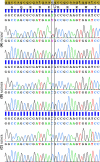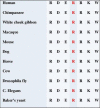Case report: An infantile lethal form of Albright hereditary osteodystrophy due to a GNAS mutation
- PMID: 30349702
- PMCID: PMC6186887
- DOI: 10.1002/ccr3.1739
Case report: An infantile lethal form of Albright hereditary osteodystrophy due to a GNAS mutation
Abstract
Germline loss-of-function GNAS mutations are associated with multiple phenotypes, depending on the parental origin of the mutant allele. Here, we describe an infantile lethal form of atypical pseudohypoparathyroidism type 1a or 1c with severe Albright's hereditary osteodystrophy phenotype, underlying the extremely variable expressivity of this syndrome.
Keywords: Albright's hereditary osteodystrophy; GNAS mutation; inactivating PTH/PTHrP signaling disorders; pseudohypoparathyroidism; severe phenotype.
Figures





References
-
- Vlaeminck‐Guillem V, Wémeau JL. Pseudohypoparathyroïdies: hétérogénéité clinique et moléculaire. Med Sci. 1999;15:1244‐1251.
-
- Thiele S, Mantovani G, Barlier A, et al. From pseudohypoparathyroidism to inactivating PTH/PTHrP signalling disorder (iPPSD), a novel classification proposed by the EuroPHP network. Eur J Endocrinol. 2016;175(6):1‐17. - PubMed
-
- Ahrens W, Hiort O, Staedt P, et al. Analysis of the GNAS1 gene in Albright's hereditary osteodystrophy. J Clin Endocrinol Metab. 2001;86:4630‐4634. - PubMed
-
- Mitsui T, Kim OH, Hall CM, et al. Acroscyphodysplasia as a phenotypic variation of pseudohypoparathyroidism and acrodysostosis type 2. Am J Med Genet Part A. 2014;164A:2529‐2534. - PubMed
Publication types
LinkOut - more resources
Full Text Sources
Research Materials

